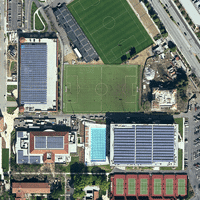Colleges across the country preach the importance of sustainability, but Santa Clara University, located 40 miles south of San Francisco, has established programs that go beyond buildings. “The university approaches sustainability with the three-prong approach—considering social equity, the environment, and economic issues—but we take their overlap very seriously,” explains Lindsey Cromwell, director of the office of sustainability. “We’ve coined the term ‘beyond green’ because we are also interested in social justice, equitable economic development, and ethics.”
Santa Clara University has won awards from the EPA and its local energy provider for its support of renewable energy and campus-generated power. The school signed the Presidents’ Climate Commitment pledging climate neutrality by the end of 2015, and initiatives to achieve this goal include installing solar panels, a solar-thermal collector, a smart microgrid, and a wind turbine. “We’ve already seen decreases in our energy consumption,” Cromwell says of these initial efforts.

The solar array at Santa Clara University generates 1.05 mW. The university plans to be carbon-neutral by 2015.
The university’s rooftop solar-photovoltaic system actually is one of the largest in the United States, producing 1.05 megawatts of solar power. “The solar-hot-water system in the student services building preheats the water, which helps to conserve natural gas usage,” says Don Akerland, the school’s director of planning and projects.
Comparing 2005 to 2011, the university saw a decrease in electricity usage of 22.8 percent per person. Within the same time period Santa Clara University also added new buildings, so the figure illustrates an overall reduction in electricity use. Waste numbers also are decreasing. Recycling, waste, and composting options are available in every campus building, down to the desk level, Akerland says. “Our landfill waste per campus user has decreased 13 percent over the last six years,” Cromwell adds. “Our waste diversion rate has increased by 50 percent.”
Campus buildings are being built to both stand the test of time and require less energy consumption; Akerland says each structure going forward is required to be built to LEED Gold standards and will harness the environmental know-how of companies like Devcon Construction, a Milpitas, California-based design-build company that has served as the LEED coordinator on several projects for the university.
The first building on campus to be awarded LEED Gold was the Paul L. Locatelli, S.J. Student Activities Center; three other projects are still pending certification. A number of components, including mechanical systems, have allowed the Locatelli building to exceed the university’s energy-savings expectations by 20 percent. “We have 6,000 hours a year where the temperatures are below 65 degrees, and half of those hours are during the workdays, so the fact that we have operable windows and that the building was designed to take advantage of the natural prevailing winds actually provides a lot of cooling for the building,” Cromwell says, and further explains that similar techniques will be used for construction in the future.
With more than 200 courses on or related to sustainability, Santa Clara University is serious about its “beyond green” language. “We’ve been identified as one of the schools in the US that has a well-developed sustainability program across the curriculum,” Cromwell says.

